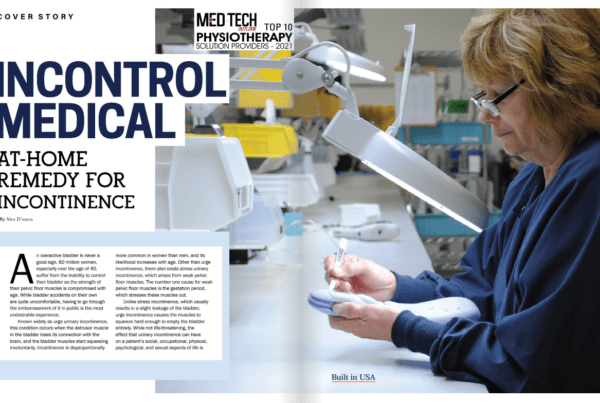
Incontinence, a taboo topic, has for long been kept under wraps. It is an eye-opener to know that a staggering 60 million women in the U.S. suffer from the embarrassing impact of urinary incontinence and another 16 million struggle with fecal incontinence in silence. The scales seem to be stacked against women, with statistics pointing that 75 percent of those suffering the consequences of incontinence are women.
Unfortunately, only a minuscule percentage, one in ten women, proactively seeks help from doctors. The majority keep it hidden, socially isolate themselves, and battle with the associated distress. For those seeking medical help, OBGYNs prescribe medications, as surgery is relatively ineffective. But on the flip side, a nested case-control study published online in JAMA Internal Medicine, warns that the long-term use of the commonly prescribed anticholinergic drugs for incontinence can increase the chances of dementia by 50 percent. Moreover, the remedy is only useful for stress urinary incontinence while it is not helpful for fecal and urge urinary incontinence.
On a positive note, non-pharmacologic treatment such as pelvic floor physical therapy effectively reduces or eliminates incontinence. But not many women have access to or are willing to follow this line of treatment.
Against this challenging backdrop, InControl Medical, a leading provider of at-home medical devices, empowers women to take control of their lives through an array of innovative home medical devices. Offering a beacon of hope, the company’s over-the-counter products have helped countless women to self-treat urinary and fecal incontinence by strengthening their pelvic floor muscles in the privacy of their homes.
“Our goal is to eliminate incontinence,” says Herschel “Buzz” Peddicord, III, founder and CEO of InControl Medical. “We have close to 93 percent success rate in restoring continence naturally.”
With close to 180,000 FDA cleared electrical stimulation devices sold to date, the ISO 13485 certified company manufactures all its products, which ticks the box on quality excellence, at its facility in Brookfield, Wisconsin. “Our products are made in America by women, for women,” adds Buzz.
”Our products are made in America by women, for women
Causes and Cure
While taking the first step to wellness, it is worth understanding the root cause of incontinence. A multitude of etiologies ranging from congenital disabilities, post-partum, anal or rectal cancer, high impact exercises, and the natural aging process are the predominant factors resulting in incontinence. However, the root cause, as in most cases, happens to be a muscle issue. It is either the weak pelvic floor muscles causing stress urinary incontinence or the overactive detrusor muscle resulting in an overactive bladder, a condition experienced by 50 percent of women above 50.
When a physical activity such as laughing or coughing, among others, puts stress on the weak pelvic floor muscles, they don’t close down on the urethra, causing urine to leak. “The first thing our device does for stress incontinence is to strengthen the pelvic floor muscles,” remarks Buzz. “In the case of urge incontinence, it is not about strengthening, instead calming the detrusor muscle and trying to stop it from spasming.” The detrusor muscle, due to several conditions, can send wrong messages to the brain. It alters the normal functioning of the bladder by contracting involuntarily and creating an urgent need to urinate even when the volume of urine in the bladder is low.
A lot of women suffer from both types of incontinence. The genesis of InControl traces back to the time when Buzz’s search for a solution to resolve stress and urge incontinence for a close family member proved futile. After selling his previous company, HomMed, LLC, which manufactured in- home health monitoring products for chronically ill patients, to Honeywell, Buzz and his team ventured into finding a cure for mixed incontinence. Drawing on their vast experience in the medical device industry, they designed the first product, InTone. This inflatable female incontinence device has helped scores of women solve the frustrating issue of involuntary loss of urine.
To treat mixed incontinence, the InControl devices are designed with two specific algorithms to transmit electrical stimulation, one for building pelvic floor muscles that include the puborectalis muscle and the other for calming the detrusor muscle. In effect, InControl’s products, as opposed to the competition, handle the two major types of urinary incontinence and fecal incontinence. While most other companies have only anecdotal information, InControl has real clinical studies supporting its unique value proposition.
Simple and Effective
As a leading player in electrical stimulation devices, InControl’s advanced technology has approximately 50 patents protecting its design. The InControl device is a transvaginal or transrectal device depending on the condition of the patient. It comes with a soft silicone insertion probe that features an inflatable balloon and, as opposed to a fixed diameter probe, contours to a woman’s body, making sure the contacts for the electrical stimulation press deep into the motor points of the muscle.
In 1948, when Kegel exercises were first described by Dr. Arnold Kegel to eliminate stress incontinence by strengthening pelvic floor muscles, he emphasized exercising against active resistance. “The balloon acts as an active resistance similar to weights in a barbell. When inflated, the pressure inside the balloon increases, making it harder for the pelvic floor muscles to contract, and thereby strengthening it quickly,” says Buzz. “Trying to squeeze the pelvic floor muscles on your own without any resistance is not going to build any muscle.”
Consider this interesting analogy: if someone went to the gym and lifted only the barbell, it would not build muscles. On the other hand, if weights are put on the barbell and raised, the muscles contract, and when the barbell is slowly brought down, the muscles are exercised the second time. Drawing parallels, the balloon in the device delivers that double exercise, firstly when a woman squeezes against it, and secondly, when the balloon pushes back.
A year ago, InControl introduced Attain, an over-the- counter, at-home device to treat stress, urge, and mixed urinary as well as bowel incontinence. Attain has a pressure sensor inside the probe, which is accurate to one one- hundredth of a pound per square inch. When a patient exercises and squeezes against the balloon, the pressure sensor measures the change of pressure, which is co-relatable to muscle strength. When the balloon is squeezed, a bar graph moves up on a display system. The farther a patient can make it go; it means the muscles are stronger. The patient can see her daily progress as she can push the bar graph up by another notch. Attain’s visual biofeedback is based on actual muscle strength collected inside the balloon, and that encourages the user that the product is doing what it is supposed to do. “Our device is designed to help build pelvic floor muscles very quickly to solve the stress urinary incontinence while another signal goes out to the detrusor muscle to calm it down and help re-establish the brain muscle communication,” explains Buzz. For effective results, patients are encouraged to use it for 10 minutes a day, six days a week, as directed for 90 days.

Buzz recalls an interesting case study where a physical therapist specializing in treating pelvic floor dysfunction, suffered from incontinence but was skeptical of using Attain. “We shipped our product for free, and she was cured of her incontinence when she tried it,” he says. Impressed with the results, she has become the brand ambassador for InControl. For every patient, she provides her regular therapy and sends them home with an Attain device to use between therapy visits. The combination of physical therapy and Attain delivers a very high success rate.
The company also offers another scientifically designed device—Intensity—for sexual health and stimulation. It is designed to help women who have vaginal laxity and have a hard time achieving orgasm. Intensity not only strengthens the pelvic floor muscles but also resultantly renews vaginal laxity, and stimulates the nerve endings both externally and internally to result in orgasms.
Fostering Positive Outcomes
More than 70 percent of InControl products are sold on a B2C basis, while the remaining 30 percent is bought by OBGYNs and internal medicine physicians who, in turn, sell to their patients.
Patients can order the product and have it shipped to their home in a discreet package. What’s more, the company offers a 100 percent money- back guarantee for dissatisfied patients after 90 days of regular exercise. The company’s innovative product portfolio is backed by excellent customer service. All customer queries are answered by female clinicians trained explicitly in incontinence, guiding patients, and walking them through the journey.
InControl plans to steer ahead with aggressive marketing programs in the fourth quarter. Alongside, a slew of products on the drawing board is set to be rolled out later this year. The latest product will be the second generation of InTone, which will measure the pressure inside the balloon down to one one-hundredths of a pound per square inch, in direct correlation to muscle strength as the patient exercises. The muscle strength data is displayed in a graph on a touchscreen, through which the patient can view her progress every day. “Nobody has displayed real clinical data, but we will be able to do that in our upcoming product. Our focus is also on reducing cost while upholding quality,” says Buzz.
Buzz attributes the company’s incredible success to his loyal, talented, and multifaceted team with decades of experience in the medical device arena. “Our culture is one of building the highest quality product possible, and there is no quality standard that we don’t already meet and exceed,” states Buzz.
In essence, InControl, with every innovative step, is well on its way to eliminating incontinence.




